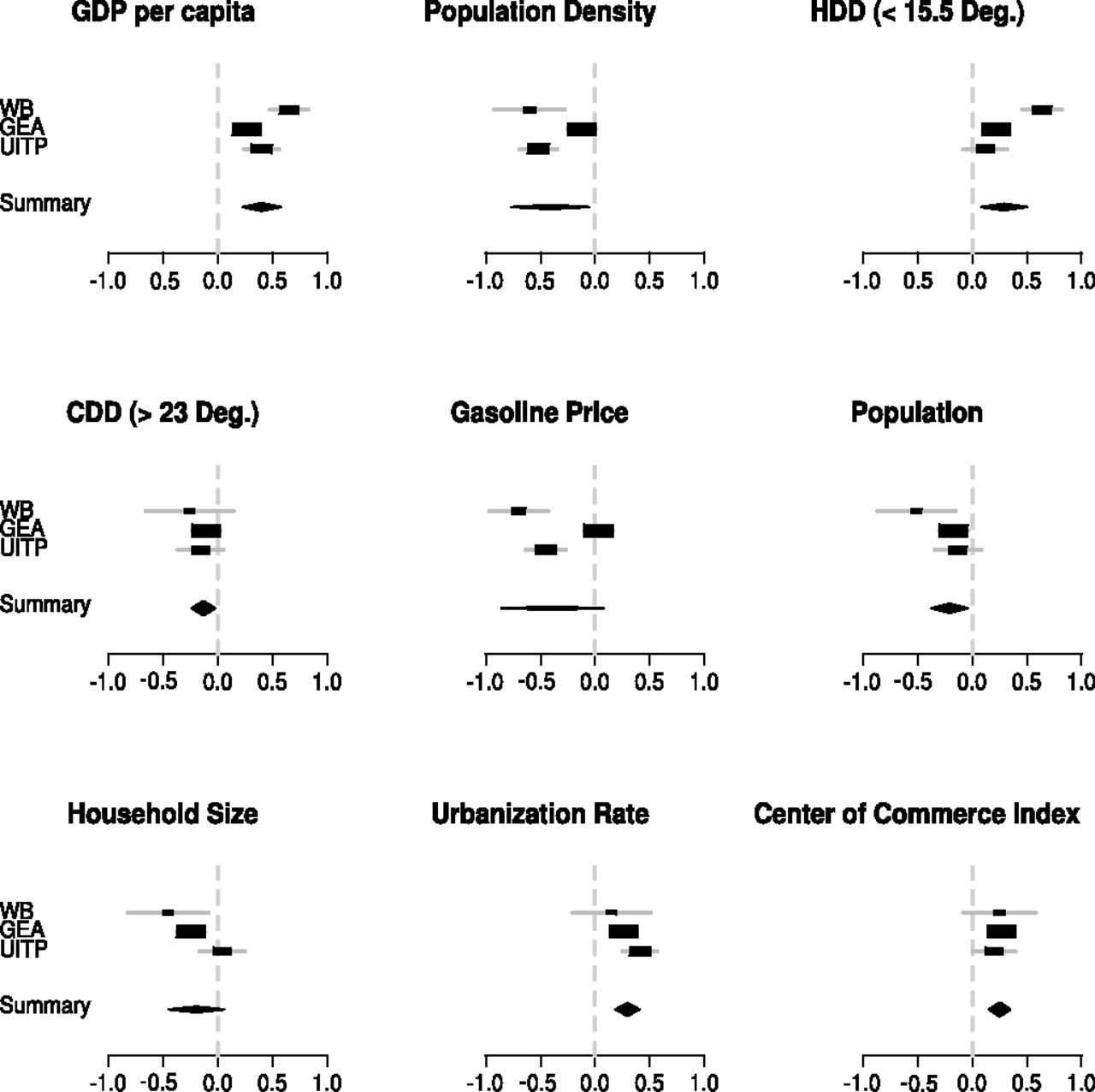文章信息:Felix Creutzig, Giovanni Baiocchi, Robert Bierkandt, Peter-Paul Pichler, & Karen C. Seto. (2015). Global typology of urban energy use and potentials for an urbanization mitigation wedge. Proceedings of the National Academy of Sciences: 112(20), 6283–6288. https://doi.org/10.1073/pnas.1315545112
整理人:杨文,2023级硕士生
整理时间:2024年8月11日
Abstract: The aggregate potential for urban mitigation of global climate change is insufficiently understood. Our analysis, using a dataset of 274 cities representing all city sizes and regions worldwide, demonstrates that economic activity, transport costs, geographic factors, and urban form explain 37% of urban direct energy use and 88% of urban transport energy use. If current trends in urban expansion continue, urban energy use will increase more than threefold, from 240 EJ in 2005 to 730 EJ in 2050. Our model shows that urban planning and transport policies can limit the future increase in urban energy use to 540 EJ in 2050 and contribute to mitigating climate change. However, effective policies for reducing urban greenhouse gas emissions differ with city type. The results show that, for affluent and mature cities, higher gasoline prices combined with compact urban form can result in savings in both residential and transport energy use. In contrast, for developing-country cities with emerging or nascent infrastructures, compact urban form, and transport planning can encourage higher population densities and subsequently avoid lock-in of high carbon emission patterns for travel. The results underscore a significant potential urbanization wedge for reducing energy use in rapidly urbanizing Asia, Africa, and the Middle East.
摘要:城市缓解全球气候变化的总体潜力尚未得到充分认识。我们的分析使用了代表全球所有城市规模和地区的274个城市的数据集,表明经济活动、交通成本、地理因素和城市形态解释了37%的城市直接能源使用和88%的城市交通能源使用。如果目前的城市扩张趋势继续下去,城市能源使用将增加两倍多,从2005年的240 EJ增加到2050年的730 EJ。我们的模型表明,城市规划和交通政策可以将2050年城市能源使用的未来增长限制在540 EJ,并有助于缓解气候变化。然而,减少城市温室气体排放的有效政策因城市类型而异。结果表明,对于富裕和成熟的城市来说,更高的汽油价格加上紧凑的城市形态可以节省住宅和交通能源的使用。相比之下,对于拥有新兴或新生基础设施的发展中国家城市来说,紧凑的城市形态和交通规划可以鼓励更高的人口密度,从而避免将高碳排放模式锁定在旅行中。研究结果强调了在快速城市化的亚洲、非洲和中东地区减少能源使用的一个重要潜在城市化楔子。

图 Pearson相关系数的置信区间(CI)
三个数据集中关键变量的能源使用以及荟萃分析的综合相关性;WB,温室气体排放;GEA,最终能耗;UITP,运输能耗。CI的中心方块与元分析中使用的权重成正比。总结措施相关CI由钻石给出;相关CI由横向钻石的尖端。灰色垂直虚线表示无效果。

图 GEA城市的三级阈值回归
经济活动将城市划分为顶层(节点1)、人口密度和汽油价格第二级(节点2和3)以及第三级(节点4-7)的HDD和人口密度。因此,出现了八种类型的城市(节点8-15)

图 能源使用量随着经济活动的增加而增加,尤其是GDP
人均<10000美元,但当人均GDP超过10000美元时,这一增长速度会放缓30000美元(按2005年购买力平价计算)。垂直灰色阴影面积表示图2中阈值回归节点1的置信区间。非常富裕的北美城市的汽油价格较低,这与整体直接能源使用的另一个小幅增长有关。

图 城市化对能源使用的潜在影响
(A) 以“一切照旧”(BAU)和低碳城市为特征的城市化楔子开发(LCUD)场景。(B) 世界不同地区情景的不确定性。中心线是中线,方框的顶部和底部是第25和第75百分位数以及线条表示总体范围。OECD90,1990年经合组织国家;LAM,拉丁美洲和加勒比;MAF,中东和非洲;REF,改革东欧和前苏联的经济。
原文链接:https://www.pnas.org/doi/abs/10.1073/pnas.1315545112